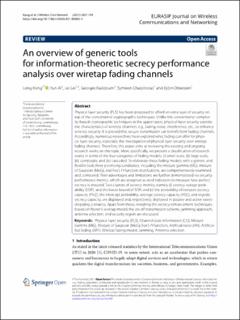| dc.description.abstract | Physical layer security (PLS) has been proposed to afford an extra layer of security on top of the conventional cryptographic techniques. Unlike the conventional complexity-based cryptographic techniques at the upper layers, physical layer security exploits the characteristics of wireless channels, e.g., fading, noise, interference, etc., to enhance wireless security. It is proved that secure transmission can benefit from fading channels. Accordingly, numerous researchers have explored what fading can offer for physical layer security, especially the investigation of physical layer security over wiretap fading channels. Therefore, this paper aims at reviewing the existing and ongoing research works on this topic. More specifically, we present a classification of research works in terms of the four categories of fading models: (i) small-scale, (ii) large-scale, (iii) composite, and (iv) cascaded. To elaborate these fading models with a generic and flexible tool, three promising candidates, including the mixture gamma (MG), mixture of Gaussian (MoG), and Fox’s H-function distributions, are comprehensively examined and compared. Their advantages and limitations are further demonstrated via security performance metrics, which are designed as vivid indicators to measure how perfect secrecy is ensured. Two clusters of secrecy metrics, namely (i) secrecy outage probability (SOP), and the lower bound of SOP; and (ii) the probability of nonzero secrecy capacity (PNZ), the intercept probability, average secrecy capacity (ASC), and ergodic secrecy capacity, are displayed and, respectively, deployed in passive and active eavesdropping scenarios. Apart from those, revisiting the secrecy enhancement techniques based on Wyner’s wiretap model, the on-off transmission scheme, jamming approach, antenna selection, and security region are discussed. | en_US |

